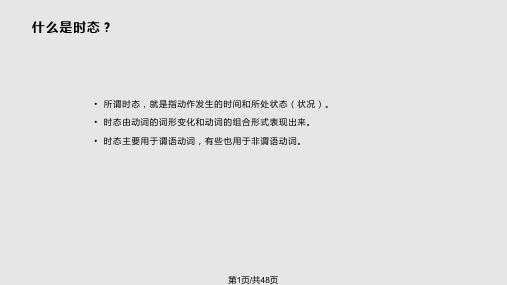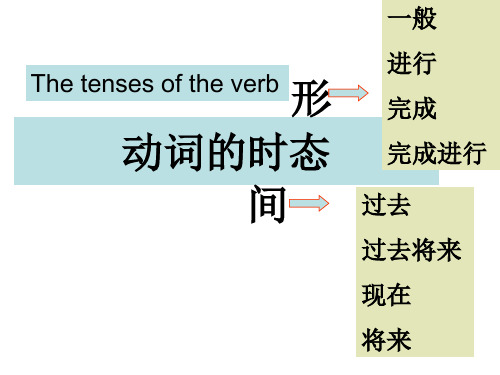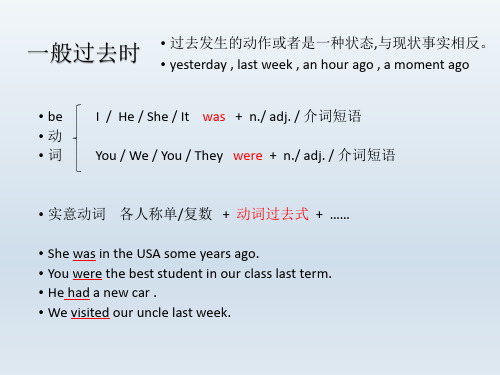动词时态完整版ppt
合集下载
动词时态PPT课件

It can’t be Jim. he has gone to town . John knows the way well. He has been to the city before .
第25页/共48页
D. 瞬间动词和持续性动词 1. 他来北京五天了。
√ He has been in Beijing for 5
过去将来完成时 现在完成进行时
过去完成进行时 将来完成进行时
过去将来完成进行时
第14页/共48页
三、时态的用法
1、一般现在时:是表述现在或经 常性的动作,状态.
A. 表述现阶段或经常性的动作,状态。 他每天骑自行车上学。
He goes to school by bike every day. B. 表客观真理
days.
× He has come to Beijing for 5 days.
第26页/共48页
D. 瞬间动词和持续性动词
2. 小明入团三年了。
Xiao Ming has been in the League for 3 years.
√
√ Xiao Ming has been a League
member for 3 years
Xiao Ming has joined the League for three years.
×
第27页/共48页
D. 瞬间动词和持续性动词
3. 这本书他买了一年了。
He has had this book
√
for a year.
× He has bought this book
练习。
完 成
先结构,
后改1,
完成 和加1
进行
第25页/共48页
D. 瞬间动词和持续性动词 1. 他来北京五天了。
√ He has been in Beijing for 5
过去将来完成时 现在完成进行时
过去完成进行时 将来完成进行时
过去将来完成进行时
第14页/共48页
三、时态的用法
1、一般现在时:是表述现在或经 常性的动作,状态.
A. 表述现阶段或经常性的动作,状态。 他每天骑自行车上学。
He goes to school by bike every day. B. 表客观真理
days.
× He has come to Beijing for 5 days.
第26页/共48页
D. 瞬间动词和持续性动词
2. 小明入团三年了。
Xiao Ming has been in the League for 3 years.
√
√ Xiao Ming has been a League
member for 3 years
Xiao Ming has joined the League for three years.
×
第27页/共48页
D. 瞬间动词和持续性动词
3. 这本书他买了一年了。
He has had this book
√
for a year.
× He has bought this book
练习。
完 成
先结构,
后改1,
完成 和加1
进行
初中英语动词的时态和被动语态(共14张PPT)

延续性动词 be on be at/in+地点 be at/in+地点 be in/a member of be on have know keep
have a cold
have been to—have gone to
曾经去过(主语人在) 已经去了(主语人不在)
--I can’t find you these days.Where have you been?
be over be up be back be away (from) be here /there
非延续性动词 put on come/go to arrive/reach/get to join begin/start buy get to know borrow / lend
catch a cold
定义 表示过去某时间或某动作以前发生的动作。
结构 关健字
S+had+V过去分词
IwSr+heheaanlidzIner’det+aIVchh过ae去dd分let词hftemcoyupHnutar.sde+Sa+t Vh过om去分e词
by the time I came back,by the end of last term, when I got to the station,before he went to bed
表示过去某时刻或某阶段正在发生的动作。
was
1.SW+hawtawsna’st /hwe edroein’gt dwohinegn the UFO arrived?
结构 S+ weredoing 2W. Tahse/yWweerree+hSav+idnoginfugn…th?ese days.
动词的时态与语态共67张PPT

was/were going to do 或 would do
the next day等
专题9 动词的时态与语态3
时态 现在进行时 过去进行时
现在完成时
过去完成时
结构 am/is/are doing was/were doing
has/have done
had done
常连用的时间状语
now, these days等 at this time yesterday, at that time, when引导的时间 状语从句等 already, yet, ever, never, so far, for three days, since two days ago等 before, when引导的时 间状语从句, by+过 去时间
结构 am/is/are+过去分词
was/were+过去分词 will be或is/are going to be+过去分词 has/have been + 过去分词
情态动词+be+ 过去分词
示例
All these things are made by machines.
This book was written by Lu Xun.
专题9 动词的时态与语6态
4.在现在完成时的句子中,如果有持续的时间状语,要把非延续性动词变为 延续性动词。如: I have had the book for two days. 这本书我已经买了两天了。(用had,而不用bought) How long may I keep the book? 这本书我可以借多长时间?(用keep,而不用borrow)
The meeting took place in a beautiful city. 会议在一座美丽的城市举行。 A fire broke out during the night.
动词的时态和语态-PPT课件

8. The man _h_a_d__h_o_p_e_d__ (hope) to catch the last train, but he was too late.
9. The boys __w_e_r_e_p_l_a_y_in_g___ (play) basketball from 5:00 to 6:00 yesterday.Βιβλιοθήκη .19练习
.
20
用所给动词的正确形式填空: 1. She _l_e_ft__ (leave) the office two
hours ago. 2. As son as she arrived home, the girl
discovered that she _h_a_d__t_a_k_e_n__ (take) her friends book by mistake. 3. Who _c_o_m__e_s__ (come) to school earliest in your class every morning? 4. Great changes _h_a_v_e_t_a_k_e_n_p__la_c_e__ (take place) in this city since 1979. 5. By the time he was twelve, Edison _h_a_d__b_e_g_u_n_ (begin.) to sell newspape21rs.
I’ll go to see you when I have time. I’ll go to see you if I have time tomorrow. 2. 某些动词,如:stand, continue, wish, love, like, hate, feel, find, think等常用一般现在时态
9. The boys __w_e_r_e_p_l_a_y_in_g___ (play) basketball from 5:00 to 6:00 yesterday.Βιβλιοθήκη .19练习
.
20
用所给动词的正确形式填空: 1. She _l_e_ft__ (leave) the office two
hours ago. 2. As son as she arrived home, the girl
discovered that she _h_a_d__t_a_k_e_n__ (take) her friends book by mistake. 3. Who _c_o_m__e_s__ (come) to school earliest in your class every morning? 4. Great changes _h_a_v_e_t_a_k_e_n_p__la_c_e__ (take place) in this city since 1979. 5. By the time he was twelve, Edison _h_a_d__b_e_g_u_n_ (begin.) to sell newspape21rs.
I’ll go to see you when I have time. I’ll go to see you if I have time tomorrow. 2. 某些动词,如:stand, continue, wish, love, like, hate, feel, find, think等常用一般现在时态
动词的时态一等奖-完整版PPT课件

eg We have lived here for ten years We had lived here for ten years when we had to move last year
现在完成时 & 一般过去时
现在完成时可表示过去发生的某一动作对现 在造成的影响或结果,强调过去发生的事情 和现在有联系; 一般过去时表示过去的动作或状态,强调过 去发生的事情与现在没有联系。
主语was/were/行为动词 过去式其他
考点一:一般过去时可表示过去发生的动作 或存在的状态,常与其连用的时间状语有 yesterday,the day before yesterday,a few minutes ago,last wee,just now,in 1999 等。 考点二:一般过去时可表示过去的习惯或经 常发生的动作,句中常有always, often, usually等频度副词。
助动词will / shall 动词原形 be going to动词原形
考点一:一般将来时表示将来要发生的动
作或存在的状态,常与表示将来的时间状
语tomorrow,net time,in a few days,net Monday,in the future,in时间段,soon, right away 等连用,其结构为“will动词原 形”。
eg She watched a movie last night 她昨晚看了一部电影。(已经看完)
She was watching a movie at nine last night 她昨晚九点在看电影。(当时正在观看)
根据句意用括号内所给动词的正确时态填 空。 1 The girl often __p_l_a_y_s_ oment Lucy
现在完成时 & 一般过去时
现在完成时可表示过去发生的某一动作对现 在造成的影响或结果,强调过去发生的事情 和现在有联系; 一般过去时表示过去的动作或状态,强调过 去发生的事情与现在没有联系。
主语was/were/行为动词 过去式其他
考点一:一般过去时可表示过去发生的动作 或存在的状态,常与其连用的时间状语有 yesterday,the day before yesterday,a few minutes ago,last wee,just now,in 1999 等。 考点二:一般过去时可表示过去的习惯或经 常发生的动作,句中常有always, often, usually等频度副词。
助动词will / shall 动词原形 be going to动词原形
考点一:一般将来时表示将来要发生的动
作或存在的状态,常与表示将来的时间状
语tomorrow,net time,in a few days,net Monday,in the future,in时间段,soon, right away 等连用,其结构为“will动词原 形”。
eg She watched a movie last night 她昨晚看了一部电影。(已经看完)
She was watching a movie at nine last night 她昨晚九点在看电影。(当时正在观看)
根据句意用括号内所给动词的正确时态填 空。 1 The girl often __p_l_a_y_s_ oment Lucy
《动词时态》课件

《动词时态完整版》PPT课件
时态介绍
简单现在时
表示经常性、习惯性的动作或存在的状态。
现在进行时
表示现在正在进行的动作。
简单过去时
表示过去发生的动作或存在的状态。
过去进行时
表示过去某一时刻正在进行的动作。
时态形式
基本形式
动词的基本形式,不带任何时 态标记。
进行时的形式
动词+be动词+现在分词形式。
完成时的形式
动词+have+过去分词形式。
一般将来时的形式
将来时态的特殊形式,用于表 示将要发生的动作或存在的状 态。
时态用法
1
简单现在时的用法
表示经常性的动作、客观事实或存在
简单过去时的用法
2
的状态。
表示过去发生的动作或存在的状态。
3
现在进行时的用法
表示现在正在进行的动作。
过去进行时的用法
4
表示过去某一时刻正在进行的动作。
时态错误
1 使用时态不规范
使用不正确的时态形式。
3 时态混淆
在表达意思时混淆时态的用法。
2 时态不一致
在同一句子或段落中使用不一致的时态。
4 常见时态错误
列举一些常见的时态错误及其纠正方法。
时态练习
单项选择题
测试学生对各种时态的掌握 程度。
完成句子
要求学生根据上下文选择合 适的时态形式填空。
翻译练习
提供一些句子,要求学生将 其翻译成英文。
总结生的时间和状态。
熟练掌握各种时态
学生需要熟练掌握各种时态, 以提高口语表达能力。
错误多练习,优化口语 表达能力
通过多次练习时态的正确使用, 可以帮助学生减少错误,提高 口语表达能力。
时态介绍
简单现在时
表示经常性、习惯性的动作或存在的状态。
现在进行时
表示现在正在进行的动作。
简单过去时
表示过去发生的动作或存在的状态。
过去进行时
表示过去某一时刻正在进行的动作。
时态形式
基本形式
动词的基本形式,不带任何时 态标记。
进行时的形式
动词+be动词+现在分词形式。
完成时的形式
动词+have+过去分词形式。
一般将来时的形式
将来时态的特殊形式,用于表 示将要发生的动作或存在的状 态。
时态用法
1
简单现在时的用法
表示经常性的动作、客观事实或存在
简单过去时的用法
2
的状态。
表示过去发生的动作或存在的状态。
3
现在进行时的用法
表示现在正在进行的动作。
过去进行时的用法
4
表示过去某一时刻正在进行的动作。
时态错误
1 使用时态不规范
使用不正确的时态形式。
3 时态混淆
在表达意思时混淆时态的用法。
2 时态不一致
在同一句子或段落中使用不一致的时态。
4 常见时态错误
列举一些常见的时态错误及其纠正方法。
时态练习
单项选择题
测试学生对各种时态的掌握 程度。
完成句子
要求学生根据上下文选择合 适的时态形式填空。
翻译练习
提供一些句子,要求学生将 其翻译成英文。
总结生的时间和状态。
熟练掌握各种时态
学生需要熟练掌握各种时态, 以提高口语表达能力。
错误多练习,优化口语 表达能力
通过多次练习时态的正确使用, 可以帮助学生减少错误,提高 口语表达能力。
英语动词时态PPT课件

01
introduction
Course Introduction
This PowerPoint courseware is designed to help learners understand and master the usage of English verb tenses. It provides a comprehensive overview of the different tenses used in English, including present, past, future, and conditional tenses.
The courseware is divided into multiple slides, each focusing on a specific aspect of verb tense usage. It includes examples, explanations, and exercises to help learners understand and apply the knowledge they have gained.
06
Non finite verb tense
Present participle tense
01
02
Summary: The present participle tense is used to show actions happening at the same time as the main verb, or actions that are ongoing.
They will understand the differences between the various tenses and when to use each one.
小学英语动词时态ppt课件

• Mom is sleeping at the moment. • The scientist is doing an experiment this week. • Jack is coming soon. (按计划将要发生的动作) • It is getting dark. (表示事物发生变化的过程)
一般将来时 • 将要发生的动作或事先计划好将要发生的动作。 • next week , tonight , in five minutes
• I / We + shall + 动词原形 + …… • 各人称单/复数 + will + 动词原形 + …… • be going to + 动词原形 + …… • Shall I / We + 动词原形 +…… (征求某人意见时) • 例句:Shall I open the window?
•
I have not finished my homework.
常用助动词:be , do , have , shall(should) , will(would)
• 4. 谓语为“情态动词+实意动词”时:
•
情态动词 + not + 动词原形
• 例句:
•
We can not go swimming this weekend.
三单
does not + 动词原形 He doesn't like ... She doesn't like ... It doesn't like ...
过去时 did not + 动词原形
• 3.谓语为“助动词+实意动词”时:
- 1、下载文档前请自行甄别文档内容的完整性,平台不提供额外的编辑、内容补充、找答案等附加服务。
- 2、"仅部分预览"的文档,不可在线预览部分如存在完整性等问题,可反馈申请退款(可完整预览的文档不适用该条件!)。
- 3、如文档侵犯您的权益,请联系客服反馈,我们会尽快为您处理(人工客服工作时间:9:00-18:30)。
注意!
表示感觉、情感、心理状态的动词如: smell , taste, sound ,look , feel ,love,like,hate ,hope,wish,want,prefer,know,understand ,remember,agree,believe,recognize,guess ,suppose(假设;认为),mean,hear,see, seem,find,mind,have(有)等通常不用进行时。
around the sun .
2.标志词:always ,often,usually,sometimes ,every day/week/month/year, once a week
3.结构:动词原形或动词第三人称单数
4.一般现在时表示将来,用于谈论时间表、日程表、 节目单等安排好的活动。句中常有时间状语,但仅用
动词时态 讲与练
一般现在时
1 含义:表示经常性、习惯性的动作,表示现 阶段的情况、动作,状态,客观存在或真理。
Our school has a big playground. I get up at 7:00 every day. His father works in a bank. She likes comedy very much. Scientists told us the earth moves
(have) an English class now.
2. Is
door?
the baby
sleeping
(sleep) next
is being polluted
3. At present the environment
三.(现po在ll进ut行e)时s表er示io一us般ly将.来时:表示即将发生的动作或按计划即
于少数几个表示“移动”的动词:come , go , arrive , begin , leave , return , start , 等。
1.The plane leaves (leave) for Paris at eight this evening .
2.The meeting
begins
将发生的动作。 常见的词有:come,leave,reach,return,go
,start,arrive, stay等。
He is leaving for Spain.他就要动身去西班牙了。
1.I am leaving
(leave) for Bejing
tomorriosw s.taying
2.Sally
(begin) at half past two tomorrow
afternoon .
5. 在时间、条件状语从句中,用一般现 在时表示将要发生的动作。
1.When he
(be)18 years old ,
he will join the army .
2. Take an umbrella in case it _____ (rain) tomorrow .
—Good morning,I wonder if you can help.I ________ my coat.
—Oh,where did you lose it,madam?
A.have lost
B.lost
C.had lost
D.lose
2.现在完成时所表示的动作开始于过去,持续 到现在,也许还会持续下去。常和for和since 这种表示一段时间的状语,或so far、up to now ,recently/lately、段时间+before, never,already,yet,during/over /in the last/past +时间等状语连用。
(stay) in her aunt’s
三、当always,constantly与进行时态连用时,表示不 耐烦、抱怨,赞美等感情色彩。
1.She is
always
such silly questions .
2. They are
(help) others.
asking (ask) always helping
3.I won’t go to his party unless she
____
(send ) an
invitation.
现在进行时
一含义:表示现在或现阶段正在进行的动作,常与now ,
at present,at this time 等连用。
二构成:am/is/are + 动词-ing
1.We are having
不能说: 1.We are wanting to take part in the lecture . 2. The food is tasting nice . 3.Kate is knowing the answers.
现在完成时
构成:has/have + v-ed
含义:
1.现在完成时所表示的动作在说话之前已完成 ,强调对现在造成的影响和结果;
的动作。 I'll wait until he has written his letter.
If I have finished my homework, I'll go with you.
注意1
短暂性动词(如:come ,go ,return , die , join , marry , buy , leave, get, begin , catch , end , finish 等 )可 语连用。如:
不能说:She has come here for two hours .
只能说 :She has been here for two hours .
1.China has changed a great deal in the
past 20 years.
2. It has rained every day so far this month.
3. It‘s the first time I have been in this town.
3.在时间 / 条件状语从句中,可以 用现在完成时表示将来某时已经完成
